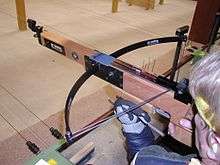Arbalist (crossbowman)
An arbalist, also spelled arbelist, is one who shoots a crossbow.[1][2][3][4][5]

Equipment and competition
Modern arbalists shoot crossbows markedly different from medieval artillerymen. Current-day target crossbows must conform to various limitations according to the governing body under which the shoot or tournament is taking place.[6][7] Firstly, GNAS requires that arbalists shoot at targets separate from archers. Both the World Crossbow Shooting Association (WCSA) and GNAS require that the draw weight maximum be 95 lbs and that the minimum bolt (arrow) length be 12 inches. These organizations differ, however, in allowable maximum bolt length, GNAS citing 15", WCSA 18". They also disagree as to whether metal prods can be used; GNAS says no, WCSA says yes (with restrictions). Both require that the bolts shall be fletched, GNAS imposing an additional constraint of the number of fletchings (three).
Classification
GNAS recognizes three grades of arbalist,[8] Master Arbalist (scoring 780 or higher in three qualifying Crossbow Windsor Rounds) Arbalist 1st Class (scoring 630 or higher) and Arbalist 2nd Class (480). A Crossbow Windsor Round is shot on a 60 cm 10-zone face scoring 9,7,5,3,1; three ends at 40 yards, three at 50 yards and three at 60 yards.
Archery Australia recognizes five classifications: Grand Master Arbelist (GMA), Master Arbelist (MA), First Class Arbelist (A1), Second Class Arbelist (A2), and Third Class Arbelist (A3).
Awards
The World Crossbow Shooting Association (WCSA) makes available four sets of Star Achievement Awards (badges) to encourage both participation in tournaments and to provide recognition for reaching certain scores: TC 900 for outdoor target crossbow, SC 600 for outdoor sport crossbow, Indoor 40 for indoor 40 cm face for both target and sport crossbow, and Indoor 25 for indoor 25 cm face for both target and sport crossbow.
See also
Notes
- An extensive list of archaic words for medieval crossbowmen is given by Payne-Gallwey.[9]
- Richardson, in his 1839 dictionary[10] did not make specific reference to the crossbow in his definition of arbalist: "One who casts or shoots from a bow."
- Hansard (1841) used the word arbalister for a cross-bowman (sic),[11] the same usage as Webster[12] and Johnson[13] who reserved the word arbalist for the crossbow itself.
- Smith[14] uses arbalist to describe a maker of crossbows.
References
- The Grand National Archery Society Rules of Shooting, Section 104, 2002
- IAU Competition Rules: Field Crossbow 2005 Art. 322 Shooting Position 322.1
- Archery Australia, Constitution & Rules Chapter 15, Target Crossbow (2007)
- "Who uses crossbows?", World Crossbow Shooting Association accessed 9/1/2008 Archived July 19, 2008, at the Wayback Machine
- Chapter 14 Crossbow Shooting Rules, Archery New Zealand Inc. Shooting Rules, 2003
- The Grand National Archery Society Rules of Shooting, Part 2 Bowstyles: Rule 210, 2002
- Target Crossbow Shooting Rules, Rule 33: Target Crossbow equipment, World Crossbow Shooting Association, 2005 (amended 2007)
- Shooting Administrative Procedure 7: Classification Schemes - 9 Crossbow Shooting (page SAP 7-4, 2002), The Grand National Archery Society
- p2 in "The Book of the Crossbow" by Ralph Payne-Gallwey, Courier Dover Publications, 1995, ISBN 978-0-486-28720-1
- "A new dictionary of the English language" by Charles Richardson, published by Pickering, 1839
- p 192 in "The Book of Archery: Being the Complete History and Practice of the Art, Ancient and Modern..." by George Agar Hansard, published by H.G. Bohn, London, 1841
- "American Dictionary of the English Language" Noah Webster, 1828 Search online Archived September 3, 2008, at the Wayback Machine
- "A Dictionary of the English Language" by Samuel Johnson, John Walker and Robert S. Jameson, published by W. Pickering, 1828
- p45 in "Crossbow Hunting" by W.H. Smith, published by Stackpole Books, 2006, ISBN 978-0-8117-3311-3
External links
- Grand National Archery Society GNAS official website
- Archery Australia Official website
- World Crossbow Shooting Association WCSA official website
- International Crossbow Shooting Union IAU official website
- The National Crossbowmen of the USA TNC official website
- Crossbowman in Stronghold Crusader The Crossbowman